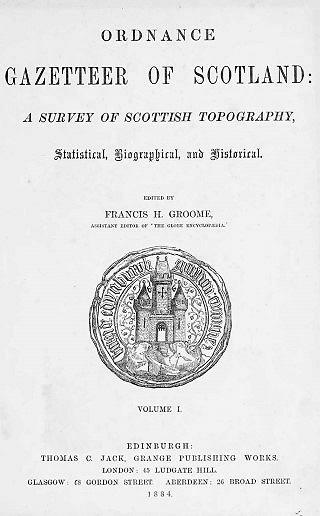|
 Gazetteers Gazetteers
by Robert M. Wilbanks IV, B.A.
Chief Genealogist & Historian, C.S.A.
genealogy@arizonascots.com
Location, location, location. A key to genealogy research is to know the right place and the right time to research the location of where your family lived, migrated, and settled. Understanding the physical geography or jurisdictional boundaries of where your family lived can be key to enhancing your ongoing family history research. As a result, every beginner genealogist quickly discovers maps as an extremely useful tool in their research. Maps allow genealogists to visually connect to and understand the geographical location where their family lived, migrated, and settled. However, maps can be limiting in detail and information.
 A reference resource known as a "Gazetteer" can provide more extensive detail of a location, including names and background information not generally found on maps. A reference resource known as a "Gazetteer" can provide more extensive detail of a location, including names and background information not generally found on maps.
A gazetteer is a dictionary of place-names. Gazetteers list or describe towns and villages, parishes, counties, states, populations, rivers, mountains, and various other geographical features.
As a written resource, usually without images, it can be used in conjunction with, or entirely without, maps. Often a Gazetteer can be a recurring publication over decades, varying by location and publisher, with each edition only being relevant to the time of publication incorporating additions and changes.
Gazetteers may be created by type of location, such as by physical geographical features, or by jurisdictions, such as by country or by towns, counties, etc., and then alphabetized accordingly.
Because the names and geographical features of a location can change over time, these historical publications are particularly helpful. Often, historical changes may be noted and included in newer editions. Additionally, when identical place names may exist in a country, a gazetteer can help distinguish the different locations.
Gazetteers may also provide additional information about towns, such as:
- Different religious denominations.
- Schools, colleges, and universities.
- Major manufacturers, canals, docks, and railroad stations.
- The population size.
- Boundaries of civil jurisdiction.
- Ecclesiastical jurisdiction(s).
- Longitude and latitude.
- Distances and direction from other cities.
- Schools, colleges, and universities.
- Denominations and number of churches.
- Historical and biographical information on some individuals (usually high-ranking or famous individuals).
Many historic gazetteers, dating to before 1930, have been digitized and can be found free and open access on the internet through sites such as Google Books (books.google.com), and Internet Archive (archive.org). You can find varying gazetteers for the United States as a whole, or by specific state. Additionally, many historic gazetteers have been transcribed in full and made available, and searchable, on the Internet. Lists and links to Gazetteers for the United States, Scotland, England and Ireland, can be found on the FamilySearch Research Wiki (familysearch.org/wiki) page.
A few of examples of gazetteers for Scotland, available online, are as follows:
- Electric Scotland
- Topographical Dictionary of Scotland, by Samuel Lewis, originally published in 1846. (British History Online).
- Gazetteers of Scotland, 1803-1901 20 volumes of descriptive gazetteers of Scotland, a comprehensive geographical encyclopedia of Scotland in the 19th century. Principal places in Scotland, including towns, counties, castles, glens, antiquities and parishes, are listed alphabetically.
- Gazetteer for Scotland, a vast geographical encyclopedia, featuring details of towns, villages, bens and glens from the Scottish Borders to the Northern Isles.
Of course, like any other aspect of genealogy, the key is to know the right place and the right time to research the location of where you family lived, migrated, and settled. Once you have the place, it is not difficult to learn all you can about the geographical and jurisdictional features of that location.
This is another of a series of articles in which I show you the basics of searching for your family history, discussing the use of family records, public records, and online resources nationally and internationally, etc. The previous articles are now available on the Genealogy Section of this website. See “Genealogy” in the menu options at the top of the web page.
|